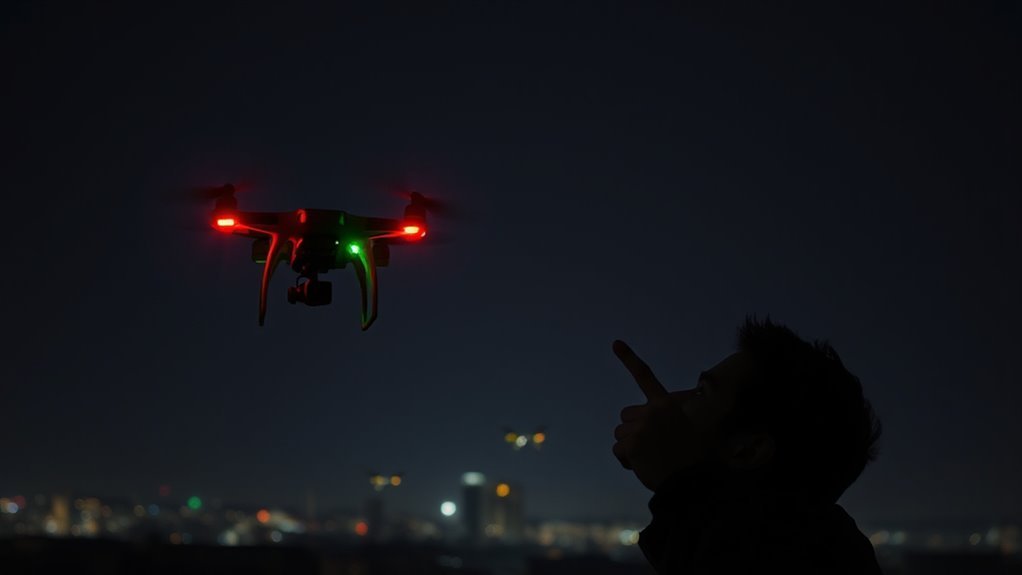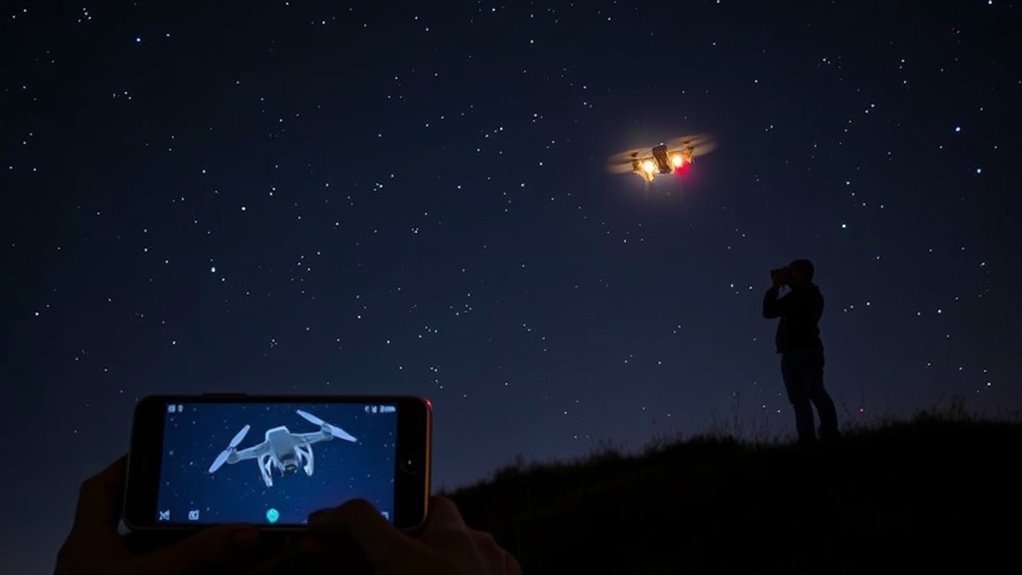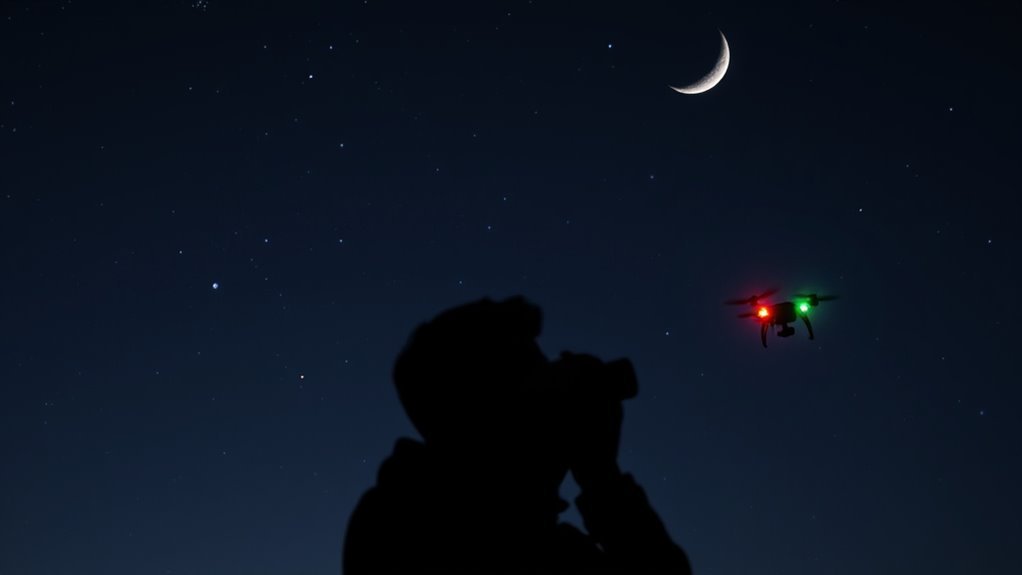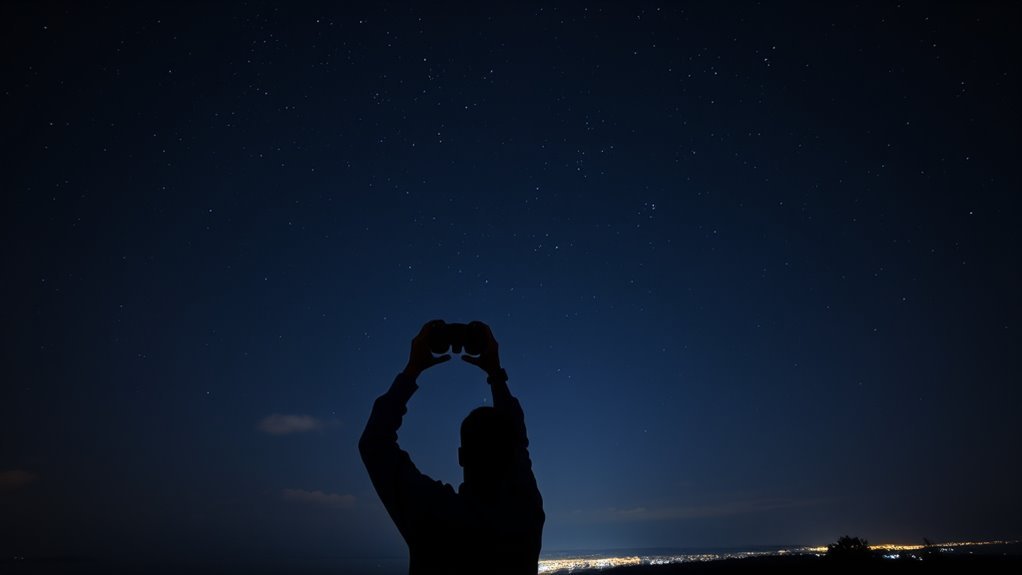To spot drones at night, focus on their lights and sounds. Look for red and green lights; red usually indicates the rear. Listen for the distinct buzzing noise drones make. Use binoculars or night vision gear for better visibility, and be aware of their flight patterns, such as sudden movements or hovering. Check local regulations about drone activity and consider mobile apps for detection. Keep an eye on your surroundings for an extensive understanding of drone presence.
Understanding Drone Lights and Their Patterns

When you’re trying to spot drones at night, understanding their lights and the patterns they create is essential. Drones typically utilize various drone light colors, including red, green, and white, to indicate direction and status. A red light often signifies the rear, while green indicates the front. Light intensity variations can further help you differentiate between drones. For instance, a steady light usually means the drone is hovering, whereas a flashing light may indicate movement or a changing flight path. Familiarizing yourself with these patterns not only enhances your ability to identify drones but also allows you to gauge their distance and altitude more accurately. This knowledge empowers you in your quest for freedom in the skies.
Listening for Drone Sounds

Although visual cues are essential for spotting drones at night, listening for their distinctive sounds can be equally important. Drones typically produce a recognizable drone noise that can help you identify their presence in the dark. This sound often falls within a specific sound frequency range, usually between 60 Hz and 600 Hz. Pay attention to the hum or buzzing noise that indicates a drone is nearby. The sound may vary depending on the drone’s size and model, but it’s often a consistent, mechanical whirring. By honing your ability to differentiate drone noise from other nighttime sounds, you’ll increase your chances of spotting drones effectively and regain a sense of awareness and control over your environment.
Identifying Drone Movement

To effectively identify drone movement at night, you’ll need to analyze flight patterns and observe light behavior. Pay attention to how the lights change direction and altitude, as this can indicate a drone’s path. Additionally, using sound identification techniques can help you distinguish drone noise from other nighttime sounds.
Flight Patterns Analysis
Understanding flight patterns is essential for identifying drone movement at night, as their behavior often deviates from that of conventional aircraft. By conducting a drone maneuverability analysis, you can recognize specific flight pattern characteristics that set drones apart. Pay attention to:
- Sudden altitude changes
- Erratic lateral movements
- Circular or zigzag paths
- Consistent low-altitude flights
- Hovering in place for extended periods
These patterns can indicate a drone’s operational intent, whether for surveillance, photography, or recreational use. Being aware of these traits not only helps you identify drones but also empowers you to assess their potential impact on your freedom and safety. Stay vigilant and informed to maintain your autonomy in the skies.
Light Behavior Observation
How can you differentiate between a drone and other airborne objects at night? Observing light behavior is essential. Drones often exhibit specific light color variations and intensity changes that set them apart from other aircraft. For instance, a drone might alternate between bright white and red lights, while traditional aircraft exhibit steady or blinking lights.
| Light Behavior | Drone Characteristics | Other Airborne Objects |
|---|---|---|
| Color Variations | Red, green, and white | Steady white or blinking |
| Intensity Changes | Pulsating or flickering patterns | Constant brightness |
| Movement Patterns | Erratic or sudden shifts | Smooth, predictable flight |
Sound Identification Techniques
Sound plays an essential role in identifying drone movement, especially at night when visual cues are limited. By honing in on specific drone soundscapes and recognizing their unique acoustic signatures, you can effectively determine the presence of drones in your vicinity. Here are some techniques to enhance your sound identification skills:
- Listen for the hum: Most drones emit a distinct buzzing sound.
- Identify variations: Changes in pitch may indicate altitude adjustments.
- Note the distance: Louder sounds suggest proximity, while softer sounds indicate distance.
- Track movement patterns: Continuous sounds may point to stable flight paths.
- Use directional audio tools: Advanced microphones can help pinpoint sound sources more accurately.
Using Binoculars or Night Vision Equipment
When spotting drones at night, selecting the right binoculars or night vision equipment is essential for effective observation. You’ll want to look for features like magnification power and low-light capabilities to enhance your ability to identify drone lights. Understanding the different types of lights drones use can also help you distinguish them from other aerial objects.
Choosing the Right Equipment
Choosing the right equipment is essential for effectively spotting drones at night. You’ll want to make sure you have the best tools to enhance your drone detection technology capabilities. Here are some key features to take into account when selecting your gear:
- Magnification: Higher magnification helps you identify distant drones.
- Field of View: A wider field allows for better tracking of moving objects.
- Low Light Performance: Essential for clear visibility in darkness.
- Durability: Make certain your equipment can withstand outdoor conditions.
- Comfort: Lightweight and ergonomic designs improve your viewing experience.
Using night vision goggles can greatly enhance your ability to spot drones in low-light conditions. Choose wisely, and you’ll gain the freedom to monitor the skies effectively.
Identifying Drone Lights
To effectively identify drone lights at night, it is crucial to understand the typical characteristics of drone illumination. Drones often use specific light patterns and colors, allowing for easier identification. Using binoculars or night vision, you can observe these details closely.
| Light Color | Common Uses |
|---|---|
| Red | Backward navigation light |
| Green | Forward navigation light |
| White | Camera or flood lights |
| Blue | Status indication |
Pay attention to light intensity variations, as these can signal different modes or statuses of the drone. By mastering drone color identification and recognizing light behavior, you can spot drones with confidence and clarity.
Observing Flight Altitudes
How can you determine if a drone is flying at a typical altitude for its operation? Understanding flight height is essential for identifying drones at night. Most consumer drones operate between 100 to 400 feet. To assess flight altitude, look for these altitude indicators:
- Sound: Drones at higher altitudes are often quieter.
- Visibility: Bright lights may indicate lower flight heights.
- Movement: Rapid, erratic movements can suggest an altitude change.
- Proximity: Drones flying nearer to you usually appear larger.
- Flight Patterns: Observe if the drone maintains a steady height or fluctuates.
Recognizing Common Drone Models
Identifying the specific drone model can greatly enhance your ability to recognize its behavior and operational characteristics at night. Familiarizing yourself with drone specifications from popular brands like DJI, Parrot, and Autel can make a significant difference in your observational skills. For instance, DJI Mavic drones often emit a distinct buzzing sound and have specific LED patterns that can help you identify them in the dark. Similarly, Parrot Anafi drones are smaller and quieter, making them less conspicuous. By understanding the unique features and flight patterns of these models, you can better anticipate their movements and intentions. This knowledge empowers you to enjoy your freedom while being aware of your surroundings and potential drone activity.
Additionally, being aware of the safety features of different drone models, such as those found in the Freefly Alta 8 Pro and DJI Inspire 3, can aid in understanding their operational behavior during night flights. For example, drones like the XG Neith are equipped with a collision avoidance system that enhances safety during nighttime operations.
Checking Local Regulations and Restrictions
Are you aware of the local regulations governing drone usage in your area? Understanding local drone laws is essential, especially if you plan to fly or spot drones at night. Here are some key points to reflect on:
- Night flying restrictions: Many regions impose limits on flying drones after dark.
- No-fly zones: Airports, military bases, and certain public areas often have strict prohibitions.
- Altitude limits: Local regulations may specify maximum flying heights.
- Registration requirements: Verify your drone is registered if it meets specific weight criteria.
- Privacy laws: Be mindful of rules regarding surveillance and photography.
Utilizing Mobile Apps for Drone Detection
As technology advances, utilizing mobile apps for drone detection has become an effective way to monitor the skies at night. These drone detection apps leverage mobile technology to identify drones in your vicinity, offering real-time alerts and detailed information. Most apps use a combination of GPS data and radio frequency signals to pinpoint drone activity, enhancing your situational awareness. When you choose an app, look for features like live maps, historical flight data, and community reporting, which can empower you to act if needed. By integrating these apps into your nightly routine, you can reclaim your sense of freedom and protect your privacy. Stay informed and proactive in your environment by harnessing the power of drone detection technology.
Staying Aware of Your Surroundings
While you may enjoy the serenity of a quiet night, staying aware of your surroundings is essential for detecting drone activity. Nighttime awareness can greatly enhance your ability to spot these devices. Remember to take into account environmental factors that may affect visibility.
Staying aware of your surroundings at night is crucial for spotting drone activity and enhancing your safety.
- Listen for unusual sounds that drones might produce.
- Observe for blinking lights that indicate a drone’s presence.
- Identify any sudden movements in the sky that seem out of place, as this could be influenced by reduced GPS and signal reliability in low visibility conditions.
- Monitor the wind direction, as it may reveal a drone’s flight path.
- Be aware of local drone regulations and common flight zones.
- Pay attention to the aerodynamic noise that may hint at a drone’s proximity, as this can help you determine its location even in low visibility.
Frequently Asked Questions
What Are the Best Times to Observe Drones at Night?
To effectively observe drones, focus on times with ideal nighttime visibility, such as clear, moonlit evenings. Enhanced drone detection occurs when ambient light contrasts with the drone’s lights, improving your chances of spotting them.
Can Weather Conditions Affect Drone Visibility?
Yes, weather conditions greatly impact drone visibility during night observation. Factors like fog, rain, or heavy cloud cover can obscure your view, making it harder to detect drones. Clear skies enhance visibility, improving your chances of spotting them.
Are Drones Legal to Fly at Night?
Yes, drones can be flown at night, but you must adhere to specific drone regulations. Make certain you use proper lighting and follow local laws to enjoy the freedom of night flying responsibly and safely.
How Can I Report a Suspicious Drone?
If you notice a drone hovering like a shadow in the night, document its suspicious behavior. Follow local reporting procedures, providing details like location and time, to guarantee authorities can investigate effectively and maintain your freedom.
What Should I Do if a Drone Is Near My Property?
If a drone’s near your property, assess its behavior concerning drone privacy and your property rights. Document the situation, and consider reporting it to authorities if you feel your rights are being violated.

